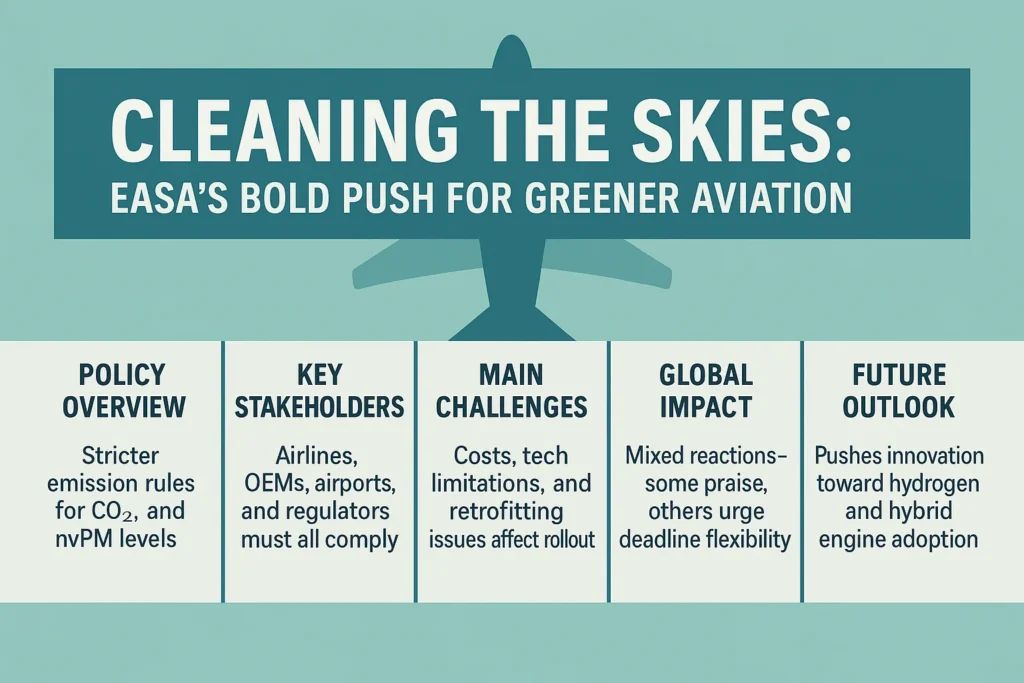EASA Environmental Guidelines on aircraft engine emissions mark a major shift in EU aviation sustainability standards and future regulations.
EASA environmental guidelines: Key Takeaways
- EASA released new environmental guidelines in 2025 to tighten aircraft engine emissions in alignment with EU climate goals.
- The rules target NOx, CO₂, and non-volatile particulate matter (nvPM), affecting both new engine certifications and legacy fleet management.
- Airlines, OEMs, and airports face new compliance costs but also opportunities for innovation.
- Reactions range from industry pushback on timelines to strong support from green advocacy groups.
- The guidelines could become a global benchmark, influencing ICAO and other regional regulators.
Introduction: The Sky’s the Limit—Or Is It?

When Europe pledged carbon neutrality by 2050, aviation—the fastest-growing transport emitter—couldn’t stay untouched.
Now, EASA has introduced a bold set of environmental performance guidelines for aircraft engines that may reshape the way airlines fly, manufacturers build, and airports operate. The policy is both a response to mounting climate urgency and a signal of leadership in sustainable aviation.
What’s in the New Guidelines?
EASA’s new engine emissions guidelines, effective from January 1, 2026, include:
- Stricter NOx (Nitrogen Oxides) emission thresholds
- Introduction of CO₂ emission performance standards for engine certification (in coordination with ICAO)
- Mandatory reporting of non-volatile particulate matter (nvPM) from turbofan engines
- Incentives for retrofitting existing aircraft with cleaner technologies
- A roadmap for full hydrogen-compatible engine certifications by 2035
These apply to new type certifications from 2026 onwards and phase in legacy fleet requirements through 2030.
Background & Context
EASA’s move follows years of scientific warnings and citizen pressure. In 2023, the EU Parliament declared aviation “an under-regulated sector in climate policy.”

ICAO’s CORSIA scheme had gaps, and Europe’s Green Deal set stricter internal benchmarks. Meanwhile, air traffic volumes are returning post-COVID, reigniting emissions concerns.
EASA also faced criticism during the 2019-2022 period for lagging behind environmental standards seen in road transport or maritime shipping. These new guidelines aim to close that gap.
Stakeholders & Affected Parties
- Airlines: Must adopt cleaner aircraft or retrofit engines; many regional carriers may struggle with the cost.
- Engine Manufacturers (e.g., Rolls-Royce, Safran): R&D budgets will need redirection; some are already testing hydrogen-compatible systems.
- Airports: May face noise and emissions audits tied to landing fees.
- Environmental NGOs: Largely supportive, but calling for even stricter nvPM thresholds.
- Passengers: Might see modest ticket price increases due to compliance costs.
Industry & Expert Reactions
“We support EASA’s vision, but the 2026 implementation date is extremely ambitious,” said Elisa Hargreaves, Sustainability Director at EuroWings Group.
“Finally, aviation is catching up to its climate responsibilities,” noted Dr. Tomasz Varga, a policy analyst at the European Climate Foundation.
Airbus and Rolls-Royce, while expressing concern over cost, have indicated they’re ready to align with EASA’s targets, citing their own sustainability roadmaps.
Implementation Challenges & Risks
- Cost burden: Smaller airlines may face insolvency without state or EU aid.
- Certification bottlenecks: EASA’s technical review teams may be overwhelmed.
- Retrofit feasibility: Not all aircraft are compatible with current green engine tech.
- Global inconsistency: If ICAO or FAA don’t follow suit, competitiveness issues could arise.
Solutions & Best Practices Emerging
- Public-private R&D partnerships are gaining ground. EASA is co-funding an initiative with Rolls-Royce and Safran on hydrogen propulsion.
- EU Green Transition Funds may offer rebates or tax relief for compliant retrofits.
- Digital emissions tracking platforms are being tested for transparent airline-level reporting.
- Training programs for maintenance crews and engineers are underway to support new engine standards.
Future Outlook
This policy positions Europe as a climate leader in aviation, likely pushing ICAO and FAA to revisit their own emissions standards.
The long-term trajectory includes a shift toward hydrogen and electric hybrid propulsion, with broader impacts on airport infrastructure, pilot training, and fleet procurement.
While turbulence is expected in the transition, EASA’s clarity could speed up private sector innovation and align aviation more tightly with global climate science.
Suggestions for Policy Amendments
- Phased targets for smaller regional carriers to avoid market collapse.
- More precise harmonization timeline with ICAO to avoid global competitiveness concerns.
- Grants for SMEs in the aircraft maintenance and retrofitting sectors to adapt quickly.
These adjustments would ensure inclusive, equitable decarbonization while preserving market stability.
Conclusion: Clearer Skies Ahead—If Industry and Policy Work Together

EASA’s 2025 environmental engine guidelines mark a central policy inflection point. They promise cleaner air, quieter skies, and climate-conscious innovation. But the path forward will test the aviation industry’s adaptability and Europe’s regulatory resolve.
If successful, the policy won’t just reshape flight over Europe—it could define what sustainable aviation looks like worldwide.
Pilot’s Handbook of Aeronautical Knowledge (2025): FAA-H-8083-25C Kindle Edition
- By Federal Aviation Administration Staff (Author) Format: Kindle Edition- 4. Rating 4.7 out of 5 stars (224)
- 4.3 on Goodreads
- 751 ratings
#1Best Sellers in Aviation Piloting & Flight Instruction
Last update on 2025-12-30 / Affiliate links / Images from Amazon Product Advertising API

